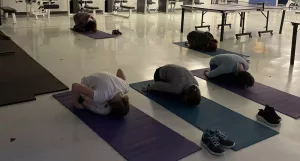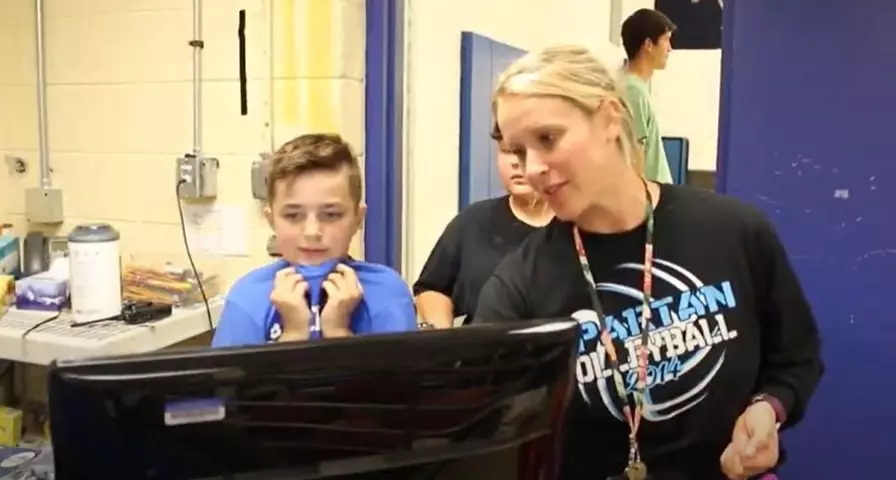Teachers rely on IHT ZONE monitors to keep middle school students active as they develop a passion for exercise
Heart rate monitors allow Glen Crest Middle School (Ill.) physical education teacher Kelly Nordlund to deliver a curriculum that motivates students to get the most out of their time in class.
“They are getting a great workout,” Nordlund said of the sixth, seventh and eighth-grade students she sees every day. “Whatever you’re doing, if you’re enjoying it you’re more likely to do it in your adult life or just out of school. And that’s kind of the whole point, right? Fitness for life and be healthy for your whole life.”
“Our district a couple of years ago was dangerously close to having PE and health as a common class where my kids, for 9-12 weeks, wouldn’t be in PE, they’d be in health,” Nordlund said. “That’s 9-12 weeks that my kids wouldn’t be active. I was desperate to find something that provides hard facts like ‘this is your kid’s heart rate,’ ‘this is what they are doing in class,’ ‘this is why PE is important.’”
Introducing IHT ZONE Heart Rate Monitors
Nordlund saw the IHT ZONE heart rate monitor at an area PE conference and liked the way the monitors engaged students and provided objective information for stakeholders. Specifically, she liked that the monitors and IHT Spirit assessment software:
- Provide real-time feedback with heart rate and a color that corresponds to the heart rate zone;
- Delivers immediate post-session feedback with an email sent directly to the student and parents; and
- Includes other visual resources and a curriculum that can be easily accessed.
Nordlund sees students just 40 minutes per day, but those 40 minutes can be essential to a student’s long-term view of physical activity.
“My class is one of the only times a lot of students get to be active, so I really want to show all of our stakeholders that this is why PE is so important,” she said.
Building Choice into the PE Curriculum
Along with the heart rate monitors, Nordlund and her colleagues began installing a curriculum that they wish had been in existence when they were middle school students. Their curriculum balances team and competitive sports with fitness activities. While students can choose to run, they aren’t forced to run the mile every week, a thought that brought back vivid memories for Nordlund.
“I remember growing up, it was every Friday and we had to run the mile,” she recalled. “I (wasn’t good) at the mile. I was a very competitive athlete. I played three sports in high school. I played college softball. I was supposed to be good at it, and that made me so anxious.”
 Instead, students choose between a variety of activities. Those who prefer competitive sports play volleyball or basketball. Those who aren’t into competition go into the fitness room and learn Zumba, practice dance moves or yoga. When the weather cooperates, Nordlund offers a fitness walking unit. The common theme remains heart rate.
Instead, students choose between a variety of activities. Those who prefer competitive sports play volleyball or basketball. Those who aren’t into competition go into the fitness room and learn Zumba, practice dance moves or yoga. When the weather cooperates, Nordlund offers a fitness walking unit. The common theme remains heart rate.
“It’s nice that I can show my kids that they don’t have to run a mile,” Nordlund said. “They just have to keep their heart rate in (a specific zone) for whatever our goal is for the day.”
Students can see their heart rate zone on their IHT heart rate monitor – blue indicates low level activity, yellow indicates moderate and red indicates vigorous. For the majority of activities, Nordlund wants students to spend the majority of their class time in the yellow zone, regardless of their overall fitness level. That’s another aspect of the heart rate monitor that works for everyone.
“It’s good, immediate feedback for the kids and it’s heart-rate specific to them,” she said. “Regardless of your fitness level, your target heart rate zone is tailored to you. If you are an elite soccer player, you can be zipping around our field and barely get into the yellow zone. But that’s because your cardiovascular fitness is crazy good and you can sustain what you’re doing.
“Then we have the kids who hate it and are always working hard,” she continued. “Well yes, it is hard. Look at the monitor and see how hard you are working. They know that if they get into the red zone, we tell them they need to back off a bit so they can get their heart rate back down.”
Creating Lifetime Movers
Nordlund wants students to find activities they enjoy that they are willing to do long after they move on from middle school. She patterns activities after things students see their parents do. She often starts class with a high-intensity tabata workout before transitioning to a yoga session so students can bring their heart rates back down. Students in the walking unit must complete a set number of laps in a time period, so they know they can’t simply walk at their leisure.
 “I think they don’t realize how challenging it really is,” Nordlund said. “For some of the kids, they are in the yellow the whole time, but now they’ve seen how, just by going for a walk – and our terrain is pretty hilly so that helps. For those kids who don’t like the other things that we offer, they see the immediate feedback and they realize that they don’t have to run a mile for exercise, they can just walk and talk with their friends.”
“I think they don’t realize how challenging it really is,” Nordlund said. “For some of the kids, they are in the yellow the whole time, but now they’ve seen how, just by going for a walk – and our terrain is pretty hilly so that helps. For those kids who don’t like the other things that we offer, they see the immediate feedback and they realize that they don’t have to run a mile for exercise, they can just walk and talk with their friends.”
Nordlund also likens her activities to what her students’ parents do for fitness. When her PE class is outside, they see adults walking together, walking dogs, heading to places like Orange Theory to get their exercise in.
“We try to relate the value of this to the kids,” she said. “Their parents spend thousands of dollars a year going to health clubs and classes and working out, and you are getting it for free in your school day. We are really trying to change the picture of PE. This isn’t your mom and dad’s PE class. We are trying to rebrand PE. I want to hit home with them how important their health is, the lifelong aspect of this. In this day and age, it’s so easy to sit still and play video games or be on your phone. That’s what I’m really hoping they take away from our classes – the importance of getting active and staying active.”
Learn More About the Spirit heart rate monitor:


